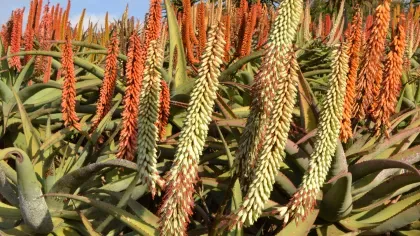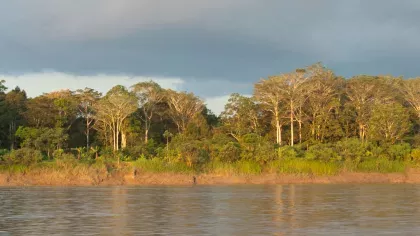18 September 2017
Treating tropical ulcers: the quest for a plant-based cure
Kew scientist Tom Prescott describes his search for a plant medicine to treat tropical ulcers in remote areas of Papua New Guinea.

Where in the world is New Britain?
To the east of Papua New Guinea lies the island of New Britain. Measuring 400 miles by 40 miles, this mountainous island contains some of the least explored rainforest on earth.
In the interior of New Britain is an area of limestone karst known as the Whiteman Range. Interspersed between limestone sinkholes and steep ravines live small groups of people leading a traditional lifestyle. Some groups/tribes are nomadic, roaming through huge areas of rainforest. Some use blowpipes to hunt small animals such as fruit bats and possums. Others carry out ritual head binding of their children to produce an elongated head shape. One nomadic group has even been secretly hiding a fighter plane that was shot down near their encampment during the World War II.
Since 1998, I have been traveling to the Whiteman Range and spent over a year living with each of these tribes to research their plant medicines. In particular, I’m interested to know if the plants they use to treat tropical ulcers are likely to be clinically effective.
Tropical ulcers
Tropical ulcers are bacterial infections, usually of the lower leg. As the name suggests, they are most common in tropical regions of the world. People in Papua New Guinea walk through the forest barefoot and if a sharp stone scratches their ankle, it soon becomes infected. What starts as a small scratch rapidly progresses into a painful round wound. In the villages of New Britain, most children have a tropical ulcer and it’s an accepted part of life – albeit a very painful and debilitating one. Although Papua New Guinea has a national health service, it isn’t accessible to people living in the remote rainforest. Could a plant provide an effective treatment for tropical ulcers instead?
Why do plants make antimicrobial chemicals?
Plants are well known for their ability to produce antibacterial compounds, a trait they have evolved to defend themselves against harmful bacteria. At a biochemical level, plant bacteria and human bacteria are very similar, so plant chemicals that kill plant bacteria can kill human bacteria too.
It’s possible that populations of people who have lived in the rainforest for 30,000 years may have inadvertently selected antibacterial plants as traditional medicines through years of trial and error. These plant medicines, which are often tree saps, are applied directly to tropical ulcers.

A plant medicine is the only option
The people of the Whiteman Range use lots of different plants to treat tropical ulcers. What medical professionals in Papua New Guinea would like to know is which of them are effective at treating the ulcer? The advantage of a plant medicine for people in remote areas of Papua New Guinea is clear: it’s the only treatment they have. Understandably, early treatment with a plant medicine from the rainforest is preferable to late treatment in a faraway clinic.
A promising start
So far, one plant looks particularly promising. Ficus botryocarpa Miq. is a small rainforest tree and is quite common in New Britain. Its sap is easy to apply to the tropical ulcer wound surface and it dries to form a flexible wound covering that deters flies. We carried out laboratory tests with tropical ulcer bacteria and found that the sap stops the bacteria from growing. In some tests it performed better than chlorhexidine gluconate, a wound antiseptic.
Next year, our partner medical team in Papua New Guinea will carry out a clinical trial. Children with tropical ulcers will be divided into two groups: 150 children will receive a tree sap treatment, and a second group of 150 children will receive treatment as usual. If successful, this knowledge can form the basis of an unusual health intervention: no pharmacies or clinics are needed and as long as there’s rainforest there’s always a treatment option.
Look out for a future update where we will let you know what our findings are.
References
Prescott, T.A.K., Briggs, M., Kiapranis, R. & Simmonds M.S. (2015). Medicinal plants of Papua New Guinea's Miu speaking population and a focus on their use of plant-slaked lime mixtures. Journal of Ethnopharmacology. 174: 217–23. Available online
Prescott, T.A.K., Homot, P., Lundy, F.T., Fang, R., Patrick, S., Cámara-Leret, R. & Kiapranis, R. (2017). Tropical ulcer plant treatments used by Papua New Guinea's Apsokok nomads. Journal of Ethnopharmacology. 205:240–245. Available online



